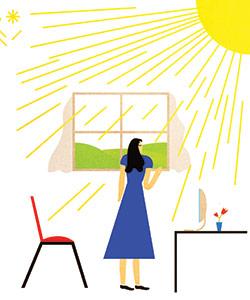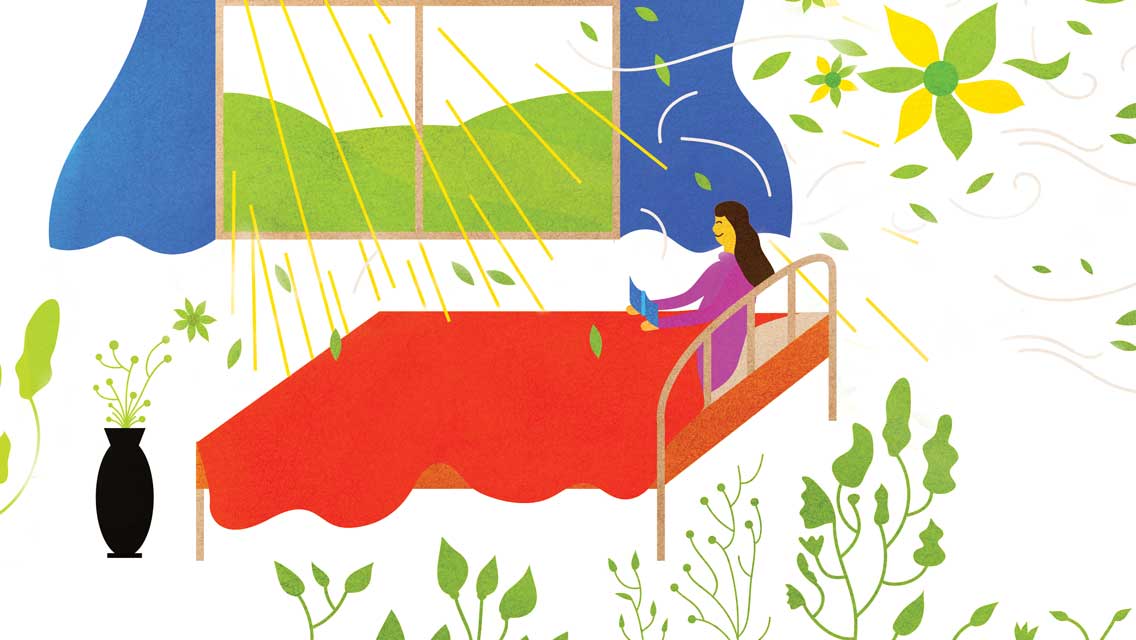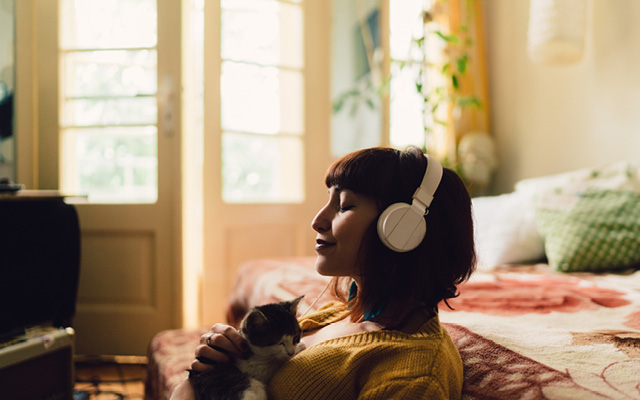If you’ve ever questioned whether a room with a view is worth the trouble, consider the following:
In 1984, medical researcher Roger Ulrich examined the hospital records of 46 patients who had undergone gallbladder surgery in a suburban Pennsylvania hospital. During recovery, half of their beds faced windows that overlooked a grove of trees. The other half had a view of a brick wall. It seems like the difference should hardly matter, but Ulrich found that patients who could see the trees left the hospital almost a full day sooner than those with a view of a wall.
Not only that, but those with views of nature required fewer doses of pain medication and had fewer negative nurse reports. Ulrich controlled for other variables that could affect recovery time, like age and sex, and each pair of patients — one with a view of trees, one a view of the brick wall — had been cared for by the same nurses, so differences in nursing could not account for the speed of their recovery.
The difference lay entirely in what they were looking at.
No one can say definitively how and why this happened, but today there is an increasing number of studies that offer interesting clues. For example, professor Irving Biederman of the University of Southern California has found that when people view scenes that are universally preferred — a beautiful vista, a sunset, a grove of trees — the nerve cells connected to the visual cortex in the opiate-rich pathway at the base of the brain become active, and the brain’s natural painkillers start flowing. It’s as if when you’re looking at a beautiful scene, your brain gives you a morphine high.
What’s more, it’s not just views of trees that have a supportive effect on health and recovery. Here are some other aspects of space and place that have also been found to have a measurable impact on healing.
Quiet Places
When you listen to the silence in a quiet place, what you really hear are the tiny sounds that are usually drowned out by background noise: dry leaves blowing across the pavement, the call of a bird, the wind in the trees.
When you are sick in bed in a hospital room, you do not hear these things. At precisely the moment you are craving peace and quiet, you hear all sorts of loud noises. The sound level in intensive-care units can range from 45 to 98 decibels. (A jackhammer at a distance of 50 feet is 95 decibels.)
The nerve cells involved in the hearing mechanism, like all nerve cells, are trained to respond to differences. Sudden change, like the rattle of a meal cart, prompts a startle response in the nervous system, a reflex that is connected directly to the stress response. This is hardly conducive to restorative rest.
In an attempt to reduce patients’ exposure to the stress of random noise, one Swedish hospital replaced sound-reflecting ceiling tiles with sound-absorbing tiles in their coronary-care unit. Noise levels were substantially reduced, and not only did patient health improve, with fewer rehospitalizations, but the staff’s personal sleep quality at home improved as well.
It’s also possible to create sound experiences that heal. Other Swedish studies found that patients undergoing hernia repair who listened to relaxing music while under anesthesia or in the recovery room required one-third to one-half the morphine of patients who did not listen to music. (See “The Healing Power of Sound” for more.)
A Place in the Sun
 As anyone who has gone to great lengths for a sunny winter vacation knows, sunlight can boost moods and physiological responses — and a dearth of sunlight can lower them.
As anyone who has gone to great lengths for a sunny winter vacation knows, sunlight can boost moods and physiological responses — and a dearth of sunlight can lower them.
The rhythms of our bodies are in tune with the rhythms of the sun. When the amount of sunlight we receive changes, either seasonally or with travel, these patterns get disrupted, and poor sleep and moods often follow. And not just any light will do — only full-spectrum sunlight, or light designed to mimic it, helps us regulate our body clocks. Prolonged exposure to fluorescent lighting, as many offices have, can dampen moods in most people, even those without clinical seasonal affective disorder.
Depressed patients in sunny rooms had significantly shorter hospital stays than their counterparts in rooms with low amounts of natural light.
Sunlight has been proven to affect not only the moods of office workers, but also the length of hospital stays in patients with depression, even if the depression is not seasonally related. Much like Ulrich’s study, two separate investigations found that depressed patients in sunny rooms had significantly shorter hospital stays than their counterparts in rooms with low amounts of natural light.
The immune system is also activated by sunlight. Exposure to moderate amounts of sun activates vitamin D molecules in the skin, which is essential for getting calcium into bones. It also strengthens the immune system, especially the macrophages, which chew up the debris produced by the body during inflammation. When fed vitamin D, the macrophages spew out immune molecules that summon other immune cells, thus speeding healing.
The Presence of Loved Ones
Most of us take for granted that we feel better in the presence of people we love, but there is a measurable reason for the comfort they provide. Just as there are hormones behind powerful feelings of attraction and passion, there are also hormonal components to feelings of love and security — and these chemicals have a powerful effect on health and healing.
Oxytocin is the best known hormone connected to feelings of maternal as well as romantic love. When we hug or kiss a loved one, oxytocin levels increase; the hormone is also stimulated during sex, birth, breast feeding, and so on. Oxytocin affects our immune system in two ways. By tuning down the stress response, it helps buffer the negative effects of stress. It also helps bolster the immune system.
Researchers at Ohio State University demonstrated oxytocin’s importance in healing in a study of Siberian hamsters, a species that pair-bonds. When socially isolated, the hamsters produced more of the stress hormone cortisol, and their wounds healed slowly. Meanwhile, when the hamsters were housed together and producing oxytocin, their wounds healed more quickly.
Another study found that human subjects had fewer upper-respiratory infections in correlation to the increase in social interaction they reported over a period of time.
Touch is another reason the presence of loved ones can be so helpful. Tiffany Field, University of Miami psychologist and researcher, noticed that when she massaged her own premature daughter, the baby’s stress behaviors immediately and perceptibly diminished. Field developed a standardized method of baby massage for preemie units and found that there were dramatic growth increases in the babies who were massaged, compared with those who received only minimal touching. After five days of massage therapy, the babies had gained a daily average of 53 percent more weight. They also slept less, a sign of physical maturation in preemies.
In 1992, Field established the Touch Research Institute in Miami, where massage and touch therapy are still being used to treat many conditions, including pain, stress, depression, and unexplained wasting in the elderly.
Places That Smell Good
If you’ve ever felt a rush of emotion at the smell of your grandfather’s potato pancakes or the scent of playground tar, you’ve experienced the visceral relationship between smell and emotion. The nose is an exquisitely sensitive chemical detector that can identify a substance based on just a few molecules dissolved in air. Our physiological response to these chemicals can inspire us to relax — or prepare for battle.
Fragrant oils have long been used for their healing effects on mood. Florence Nightingale moistened the foreheads of wounded soldiers with lavender oil, famed for its relaxing effects. Several recent studies show that a number of fragrant oils like lavender can indeed ease tension, improve mood, and induce sleep.
One experiment found that rats that inhaled valerian and rose scents slept longer, while lemon odor shortened their sleep. Brain electrical activity in these rats, measured by electroencephalogram (EEG), also changed accordingly. By contrast, rats that had lost their sense of smell showed no such effect.
Another study, focusing on humans, showed that lavender oil helped treat mild insomnia. EEG changes characteristic of positive moods have also been shown in people inhaling the oil. Lavender also decreased memory and reaction times, which would be expected in a compound that causes drowsiness.
Walking Paths and Labyrinths
 When you walk at a regular pace, breathing deeply and evenly, the vagus nerve and its soothing rhythms take over the adrenal gland, with its adrenaline and cortisol rush. The beating of your heart and the tempo of your breathing synchronize in calming, undulating waves. As you take a deep breath, your heart rate slows; as you let it out, your heart speeds up just a bit. The very brief time between beats increases and decreases in sync with these breaths. Your blood pressure falls, and instead of blood vessels clamping down to keep up blood flow to the vital organs, your heart pumps more strongly and effectively. The brake to your stress response has been engaged.
When you walk at a regular pace, breathing deeply and evenly, the vagus nerve and its soothing rhythms take over the adrenal gland, with its adrenaline and cortisol rush. The beating of your heart and the tempo of your breathing synchronize in calming, undulating waves. As you take a deep breath, your heart rate slows; as you let it out, your heart speeds up just a bit. The very brief time between beats increases and decreases in sync with these breaths. Your blood pressure falls, and instead of blood vessels clamping down to keep up blood flow to the vital organs, your heart pumps more strongly and effectively. The brake to your stress response has been engaged.
Regular walking, just 30 minutes a day, bolsters the immune response, especially the cells that are the immediate defenders against infection. Elderly individuals who walk an average of 7,000 steps a day register the strongest immune response among their peers. They have more first-line defense antibodies in their saliva — the antibodies that help prevent colds, upper-respiratory infections, and sinusitis.
The health benefits of walking in themselves are important, but there are additional rewards when one walks the path of a labyrinth. Unlike a set of city streets, a labyrinth has one path. It is calming, because it forces you to focus your attention on the way in front of you. It makes you walk slowly and breathe evenly in rhythm with your pace. There is something intrinsically soothing in this ritual — which may be why it’s becoming a standard practice in complementary and alternative medicine.
Today there’s even a labyrinth at the National Institutes of Health. The Clinical Center labyrinth is silk-screened on a large canvas. On the first and third Tuesday of each month, it is rolled out onto the floor in a wide atrium at the back of the hospital. To come upon this space is a surreal experience. The last place one might expect to find a labyrinth is in the flagship hospital of one of the world’s leading institutions in conventional medical research. But it remains a popular place for all who need respite from a hectic day. The healthcare staff use it just as much as the patients and their families.
Standing at the entrance to any labyrinth, you can see there’s no route in or out — and if you try, it will defeat its purpose of putting you at ease. You should simply start. Trust that if you follow the path you will not get lost, and that you will come out feeling better than when you began. In many ways, this is a metaphor for any spiritual journey.
Places of Belief
In 1858, a 14-year-old girl named Bernadette Soubirous saw visions of the Virgin Mary at a spring in Lourdes, and ever since, this town in southwestern France has been a center of healing. Each year it attracts approximately 6 million visitors and 80,000 ailing pilgrims who come with the hope of finding healing. There have been 67 acknowledged miracle cures since Soubirous saw her first visions.
There could be many reasons for the unexplained cures. Some cases of multiple sclerosis or arthritis might have been caused by infections like Lyme disease, which eventually cleared up. Still, the timing of the cures, which all coincided with powerful emotional experiences, points to the role of emotion, and more specifically, belief, in the healing process.
Just as when we are stressed and the brain fires up its stress response, when we believe in the healing process, it shifts into a belief response. It has taken researchers much longer to work out the biology of belief than to work out the biology of stress — partly because it’s easy to put a person or an animal in a stressful situation and then measure something. It’s a lot harder to tell a person to believe, and then measure an effect.
The feeling described by pilgrims at Lourdes bears a strong resemblance to perceptions expressed by Buddhist monks who follow a type of Tibetan practice called loving-kindness meditation. University of Wisconsin researchers have conducted brain studies with such Tibetan monks; during meditation, their scans reveal elevated activity in the reward circuits and parts of the brain connected to positive emotions and resilience.
Many Lourdes pilgrims have described an overwhelming sense of love and warmth as the first sign of a cure. A 36-year-old woman with severe MS wrote in her testimony, “The first miracle of Lourdes, in my opinion, is the feeling you have when you enter the sanctuary — the sensation of entering a bubble of sweet gentleness and peace. The place is bathed in prayer, and the atmosphere is intensely warm with love. It is absolutely magical.”
However one interprets miracle cures, something real happens at Lourdes. Visitors find a loving, supportive community where they are accepted for who they are, no matter what their illness. And with them they bring their hopes and expectations for a cure.
Two essential elements that can help an individual heal are expectation and social support. Lourdes offers both.
Finding Your Place
How can we use this information to stay healthy — or to heal from illness? It’s almost too simple.
Rather than rushing through our days without paying attention to the spaces around us, we need to carve out a few moments to allow ourselves to be aware of our place in the world — and its place inside us.
We need to allow ourselves time to see the sun glinting off the surface of leaves, or to stop and inhale the smell of ocean salt. We need to feel the touch of a spring breeze.
Whether we are healthy or ill, we need to let these sensations penetrate us. We need to take time for the memories they trigger, good and bad, to percolate to the surface. We need to let those memories take hold of our emotions and take time for reverie. Perhaps it was doing all this that allowed those patients with views of nature to heal faster than those with a view of a brick wall.
Ultimately, it is really in ourselves, in our memories, thoughts, and beliefs, that we each find our healing space. The most powerful of healing spaces is in the mind.




This Post Has 0 Comments